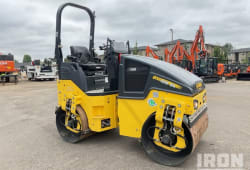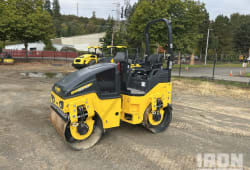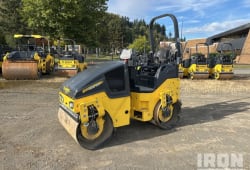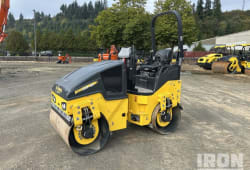Understanding Why Compactors Are So Important
9 Min read
)
September 4, 2023
Soil compactors are a crucial tool in the world of construction and engineering, playing a vital role in ensuring the stability and durability of various structures. In this comprehensive guide, we'll dive deep into the world of soil compactors, exploring their functions, types, benefits operational costs, and much more. If you're new to the concept of soil compaction or seeking expert insights, you're in the right place.
What is Soil Compaction?
Soil compaction refers to a process in which the density of soil is increased through mechanical means. This process aims to make the soil more tightly packed, reducing the amount of space between its particles and enhancing its ability to support weight and loads. The primary goal of soil compaction is to improve the soil's strength and stability, making it suitable for various construction and engineering purposes.
To achieve soil compaction, heavy machinery, such as large compactors, is used. These machines apply significant pressure to the waste soil, effectively squeezing the air out from between the soil particles. The removal of air voids results in a denser and better-compacted waste soil structure, which is better equipped to withstand the stresses and pressures that it may encounter over time.
By compacting the soil, construction professionals create a solid foundation that can bear the weight of structures, vehicles, and other loads without significant settling or shifting. Properly compacted soil prevents the formation of voids that could lead to uneven settling, structural damage, or other issues that could compromise the integrity of construction projects.
How Does Soil Compaction Work?
Soil compaction is a process that relies on the application of mechanical force to alter the structure of soil in a controlled manner. The goal is to enhance the soil's properties to make it more suitable for construction and other engineering purposes.
When compacting soil, mechanical force is exerted onto the soil particles. This force causes the particles to come closer together, reducing the spaces between them. These spaces, known as pore spaces, are the gaps between soil particles that can hold air or water.
As the mechanical force is applied, the pore spaces in the soil are diminished. This results in a significant increase in the overall density of the soil. In other words, the soil becomes more tightly packed and closely compacted. The reduction in pore spaces also leads to an increase in the soil's load-bearing capacity.
Denser soil has improved structural integrity and stability, making it less prone to settling, shifting, or deformation under pressure. It provides a solid and reliable foundation for construction projects, ensuring that structures built on compacted soil remain level and secure.
The Benefits of Soil Compaction
Effective soil compaction brings about a range of environmental impacts and advantages that contribute to the success and longevity of construction projects. This process, which involves compacting soil to increase its density and strength, offers a host of benefits that significantly impact the quality and durability of the materials and the final structures.
Improved Structural Integrity
One of the primary benefits of soil compaction is the improved structural integrity it imparts to the ground. Compacted soil possesses greater resistance to deformation and settlement, which means it can better support the weight of buildings, roads, and other structures. The compacted soil provides a solid and reliable foundation that reduces the risk of structural failures, such as cracks or uneven settling, over time.
Increased Stability
Compacted soil offers increased stability which is essential for any construction project. By minimizing the presence of voids and air pockets within the soil, compaction ensures that the ground beneath a structure remains stable and secure. This stability is crucial for preventing shifts, tilts, or other movements that could compromise the safety and functionality of the construction.
Enhanced Drainage Capabilities
Soil compaction plays a role in enhancing the drainage capabilities of the soil. Compacted soil allows for better water flow and drainage, as the reduced volume of pore spaces prevents water from becoming trapped within the ground. This property is particularly valuable in preventing waterlogged soil, which can weaken the foundation of structures and contribute to erosion or other issues.
Reduced Risk of Soil Settling
One of the key advantages of soil compaction is its ability to reduce the risk of soil settling over time. Settlement occurs when soil gradually sinks or shifts due to the weight of a structure or other external factors. Compacted soil is less susceptible to settling, ensuring that the ground remains stable and level, even after years of use.
Safer and Longer-Lasting Projects
Ultimately, the benefits and cost of effective soil compaction culminate in the creation of safer and longer-lasting construction projects. By providing a solid and stable foundation, compacted soil contributes to the overall safety and durability of structures. This results in reduced maintenance requirements and a prolonged lifespan for buildings, roads, and other infrastructure.
Choosing the Right Soil Compactor
:format(webp))
The process of selecting the optimal soil compactor for your construction project is an endeavor of utmost significance. It hinges upon a delicate interplay of various critical factors that collectively shape the efficacy and success of the compaction process. Navigating through this decision-making journey demands a comprehensive understanding of the intricate variables at play.
Tailoring Equipment to Soil Characteristics
A pivotal consideration in choosing the right soil compactor system revolves around the inherent characteristics of the soil itself. Different soil types possess unique properties that can profoundly influence compaction dynamics. Cohesive soils, such as clay, necessitate a different approach compared to granular soils like sand. A compactor system's ability to adapt to the specific attributes of the soil is paramount, ensuring that the machinery can effectively transmit force and pressure to achieve optimal compaction.
Delving into Compaction Depth
Another decisive factor in this process is the compaction depth required for your project. The depth to which compaction is needed will dictate the type of compactor that can fulfill the task efficiently. Deeper compaction demands robust equipment with the capacity to exert force effectively at greater depths, while shallower compaction necessitates a different set of specifications. Understanding the compaction depth is crucial in aligning equipment capabilities with project requirements.
Scaling to Area Size
The expanse of the area slated for compaction is a pivotal parameter that significantly influences equipment selection and compactor program. The sheer size of the designated area plays a pivotal role in determining the appropriate size and capacity of the compactor. For larger areas, a compactor with a broader compaction width can expedite the process, whereas smaller areas may warrant more compact and agile machinery. Matching the equipment scale to the project's dimensions ensures optimal efficiency and timely completion.
Balancing Power and Precision
The art of choosing the right soil compactor is an intricate dance between power and precision. While powerful compactors exert substantial force, ensuring deep and thorough compaction, precision compactors excel in delicately navigating tighter spaces and intricate contours. Striking the right balance between power and precision aligns the equipment's capabilities with the nuanced demands of the project, resulting in a harmonious fusion of effectiveness and finesse.
Ergonomics and Operator Comfort
In this selection process, it's imperative not to overlook the ergonomics and operator comfort associated with business operations with the chosen compactor. The ease of maneuverability, control interfaces, and operator comfort contribute to the overall efficiency and safety of the compaction process. An equipment choice that enhances operator well-being fosters a conducive environment for achieving precise and consistent compaction results and reducing waste volume.
Common Soil Compaction Problems
Despite its benefits, soil compaction can lead to challenges such as decreased drainage and root penetration. Understanding these issues can help you mitigate potential problems.
Technological Advancements
The future of soil compaction is tightly intertwined with technological advancements. Engineers and construction professionals are increasingly leveraging cutting-edge technologies to enhance the effectiveness and precision of soil compaction processes. One notable area of innovation is equipment design, where modern compact recycling equipment is being engineered with greater efficiency, versatility, and automation.
Data-Driven Approaches
A significant shift in the future of soil compaction is the emphasis on data-driven approaches. Construction sites are becoming more digitally connected, allowing for the collection and analysis of real-time data related to soil characteristics, compaction performance, and other critical metrics. This data-driven insight empowers professionals to make informed decisions, adjust compaction parameters in real time, and optimize the compaction process for maximum efficiency.
Integration of Sensors and IoT
The integration of sensors and Internet of Things (IoT) devices is revolutionizing how soil compaction is monitored and managed. These technologies provide continuous feedback on soil density, moisture levels, and compaction quality. By utilizing sensor data, construction teams can ensure uniform compaction throughout a project, identify potential issues early on, and make necessary adjustments to achieve desired compaction levels.
Environmental Considerations
The future of soil compaction also places a strong emphasis on environmental considerations. Sustainable practices and eco-friendly solutions are becoming increasingly important in construction projects. Innovations in soil compaction techniques are exploring ways to minimize energy consumption, reduce emissions, less waste, and optimize resource usage, aligning with the company's footprint and broader environmental goals.
Enhanced Predictive Models
Advanced predictive models are playing a crucial role in shaping the future of soil compaction. These models leverage historical data, machine learning, and artificial intelligence to forecast soil behavior and compaction outcomes. By simulating different scenarios, construction teams can make informed decisions before commencing work, leading to more efficient and effective compaction processes.
Conclusion
In conclusion, soil compactors are indispensable tools that play a crucial role in ensuring the stability and longevity of construction projects. By understanding the principles of soil compaction, selecting the right equipment, using waste materials, and following best management practices for commercial compactors, you can contribute to safer and more durable structures.
Commercial trash compactors can help businesses save landfill space by reducing the volume of trash bags they need to use, which can also help to improve waste management and recycling programs. waste compactors can help to reduce the volume of waste produced, which can lead to environmental benefits such as less pollution and less need for landfill space.

Javier Bocanegra is Boom & Bucket's Technical Resolutions Lead, drawing on 10+ years in automotive and heavy equipment to diagnose issues, resolve complex post-sale cases, and keep machines - and customers - running smoothly. A certified heavy-equipment specialist, he's known for meticulous inspections and hands-on expertise across mechanical, electrical, and hydraulic systems. Based in Sacramento, Javier partners closely with buyers, vendors, and our field teams to deliver reliable outcomes and uphold our standards for safety and trust.














